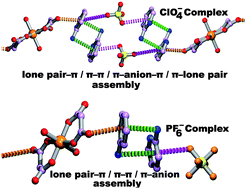Two nickel(II) malonate coordination compounds, namely (C5H7N2)4[Ni(C3H2O4)2(H2O)2](ClO4)2 (1) and (C5H7N2)4[Ni(C3H2O4)2(H2O)2](PF6)2 (2) [where C5H7N2 = protonated 2-aminopyridine, C3H4O4 = malonic acid, ClO4− = perchlorate, PF6− = hexafluoridophosphate], have been synthesized from purely aqueous media, and their single-crystal structures have been determined by X-ray diffraction. As anticipated, various weak forces, i.e. lone pair–π, π–π and anion–π interactions, play a key role in stabilizing the self-assembly process observed for both compounds. Intricate combinations of lone pair–π, π–π and anion–π interactions of the type lone pair–π/π–π/π–anion–π/π–lone pair and lone pair–π/π–π/π–anion are observed that are fully described, including by computational methods. The theoretical calculations allow estimating the strength of these π contacts.
You have access to this article
 Please wait while we load your content...
Something went wrong. Try again?
Please wait while we load your content...
Something went wrong. Try again?


 Please wait while we load your content...
Please wait while we load your content...